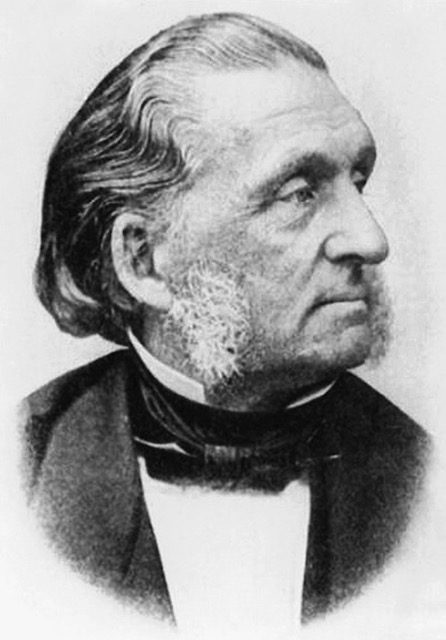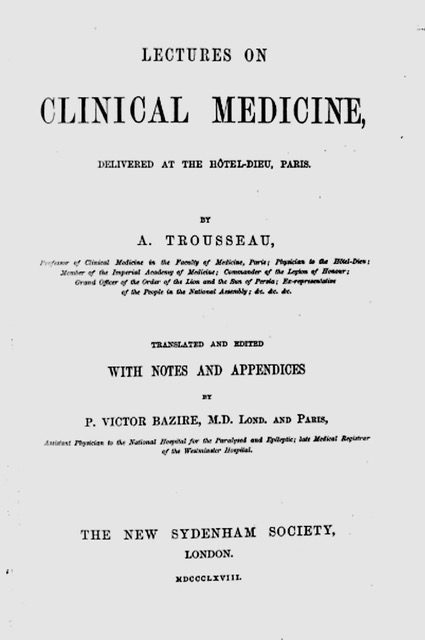JMS Pearce
Hull, England

“Every science touches art at some points—every art has its scientific side; the worst man of science is he who is never an artist, and the worst artist is he who is never a man of science.”
– Armand Trousseau
Trousseau’s sign is familiar to medical students as the carpopedal spasm caused by hypocalcaemia or by overbreathing, which he described as the “intermittent rheumatic contractions, and still better called tetany.”
Trousseau was a crucial part of the bridge between the older medicine of restless curiosity and a new logical, ordered system of clinical investigation. His approach echoed the medieval religious rational “scholasticism” of Peter Abelard (1079–1142) and St. Thomas Aquinas’s (c. 1225–1274) acquisition of knowledge by reason: “to have scientia requires grasping the cause of the thing known.”
Armand Trousseau (1801–1867) was born in Tours in France’s Loire Valley. He studied under Pierre Bretonneau (1778–1862), physician in Tours, and read medicine in Paris where he graduated in 1825. He was to become a brilliant clinician and a superb teacher who was venerated by students and colleagues for his ingenuity, integrity, and generosity.
He was sent to study yellow fever in Gibraltar. Tuberculosis (phthisis) was then rife in his native France and so he became interested in laryngeal phthisis, usually a preterminal phase of pulmonary tuberculosis. His monograph on the subject1 was well received. His standards were high and he published many scholarly works. In 1833 with Henri Gouraud and Jacques Lebaudy, he founded the Journal des connaissances médico-chirurgicales, in which he published many papers. These works afforded him further professional recognition and a substantial practice. This led to his appointment at the age of thirty-eight as physician to the Hôpital St. Antoine in 1839, and to the Hôtel Dieu in Paris in 1850.
Much of his early work related to his chief Pierre Bretonneau’s (1778–1862) cases of diphtheria, a disease common before immunization with a formidably high mortality rate often caused by laryngeal obstruction by the diphtheritic pseudomembrane. After Bretonneau’s single case in 1825, Trousseau was the first physician to perform a tracheostomy in 1833,2 which in about twenty-five percent of his many subsequent cases proved life-saving. Trousseau’s comment3 shows his optimism and amazing, understated surgical courage:
I have not hesitated to perform the operation upon children dead—that is to say, no longer breathing, and they got well. This extreme degree of asphyxia is an inconvenience, but it is not a formal contra-indication.
He is also said to have been the first to perform thoracocentesis to drain pleural effusions.

Many of his divers investigations and descriptions, including that on tetany, were published as Lectures on Clinique Médicale de l’Hôtel Dieu, Paris.4
Apart from tetany, the disorder for which he is best remembered is Trousseau’s syndrome (“Phlegamsia Alba Dolens”), described in 1865 as venous thrombosis coincident with or as a forewarning of visceral carcinoma5:
This frequent occurrence of phlegmasia alba dolens with an appreciable cancerous tumor, led me to the inquiry of whether a relationship of cause and effect did not exist between the two, and whether the phlegmasia was not the consequence of the cancerous cachexia.
Ironically, two years later, Trousseau himself developed this syndrome as a result of gastric carcinoma.
Tache cérébrale is the red streak he described on scratching the skin in acute cerebral illnesses, especially meningitis. His description suggests some variant of dermatographia in response to fever; yet he claimed a high degree of specificity for the sign.
An outstanding clinician, his novel clinical observations included the first description of hemochromatosis in 1865, described by Troisier in 1871 as diabète bronze et cirrhose pigmentaire, and named hemochromatosis by von Recklinghausen in 1889. He renamed pernicious anemia “Addisonian anemia.” He recognized the similarity of rickets and osteomalacia, and treated rickets with milk and cod liver oil long before their vitamin D content was known. Trousseau compiled a valuable two-volume treatise on therapeutics,6 which embodied contemporary opinions about materia medica, interspersed with much of his original experiences (see Garrison and Morton7).
He supported the notions based on Pasteur’s work on fermentation. In puerperal sepsis he anticipated the conclusions of Joseph Lister, observing:
…In the atmosphere a morbid germ, which being deposited on the umbilical, or placental, wound, or on any surgical wound, will produce in one case phlebitis, and in another erysipelas, with or without purulent infection… I believe that hospital hygienics embrace means by which the germs of infection may be neutralised, and its progress modified, should the germs become developed…4(Vol. 5:271)
Forty-four years after James Parkinson’s Essay On The Shaking Palsy, Trousseau described in 1861 both bradykinesia and rigidity—signs that Parkinson had neglected. He also described the smooth muscle disorder of Parkinsonism: “Weakness of the genito-urinary organs is still more marked than that of muscles. In males impotence sets in rapidly, and towards the last the urine is retained with difficulty.”8 He vividly described the gait disorder—“he is obliged to run after himself, as it were, so that he keeps trotting and hopping on,” referred to by Parkinson as scelotyrbe festinans.
Trousseau introduced the term aphasia, amending Broca’s aphemia. He observed almost all aspects of aphasia, including defective writing and reading, and the effects on memory as well as on artistic abilities.9 Amnesia for words was the most prominent symptom. His descriptions highlighted many cases of language disorders in celebrities of his time.
In the eighteenth century, the word chorea had covered many different movement disorders. But Trousseau emphasized its relation to rheumatic fever: “of all the predisposing pathological states [of chorea], rheumatism is assuredly the most marked and the least questionable.” This finally established the rheumatic nature of Sydenham’s chorea as distinct from diverse choreic disorders. He also examined the mechanisms of stupor in cerebral hemorrhage.
Lecture 3 (Trousseau 1868)10 contains an exemplary and detailed account of almost all the types of epileptic attacks, the auras, mental symptoms, and sequelae with which the twenty-first century neurologist is familiar. He gave details of petit mal, haut mal, status epilepticus and a variety of partial seizures. The richness of his descriptions parallels if not exceeds that of Gowers in 1907.11
Under the title “Epileptiform Neuralgia” in Lecture 4, he distinguished two varieties of trigeminal neuralgia: “The more common is neuralgic pain unattended by convulsive twitches; the other is accompanied by convulsive movements, and I designate it tic douloureux…”
Trousseau gave an account in 1873 of the syndrome subsequently described and named after Gilles de la Tourette in 1885. Jean Marc Gaspard Itard had, however, in 1825 reported a similar affliction marked by sudden tics, vocal outbursts, and obscenities of the aristocrat Marquise de Dampierre.
Trousseau’s acolytes included Jacob Da Costa, Brown-Séquard, and Lasègue. His son, Georges Phillipe Trousseau, became the royal doctor in Hawaii, and his grandson was Armand Henri Trousseau, a well-known ophthalmologist. He also supported the young Charcot and publicized the work of Duchenne de Boulogne on Romberg’s tabes dorsalis. His wide spectrum of inquiry covered much of medicine. His profound explorations of clinical, pathological, and pathogenetic processes are extraordinary.9 Even more impressive is his analysis and critical reasoning of disease processes about which there was but sparse information of basic mechanisms in his time.
The Menus de Paris – Square Armand Trousseau, a public garden, and the Hôpital Armand Trousseau, 26 Avenue du Docteur Arnold Netter 75 Paris, commemorate his name.
References
- Trousseau A. Belloc PH. Traité pratique de la phthisie laryngée, de la laryngite chronique, et des maladies de la voix. Paris JB Baillière 1837.
- Trousseau A. Mémoire sur un cas de trachéotomie pratiquée dans la période extreme de croup. J. Connais méd.-chir 1833;1:5, 41.
- Notes Taken from Lectures of M. Trousseau, on Croup and Diphtherite. Buffalo Med J Mon Rev Med Surg Sci. May1853;8(12):740-746.
- Trousseau A. Clinique Médicale de l’Hôtel Dieu de Paris. Tom 2. Paris, J.-B Baillière 1861. translated P.V. Bazire: Lectures on Clinical Medicine, delivered at the Hotel Dieu, Paris. London, New Sydenham Society,1868.
- Trousseau A. Phlegmasia alba dolens. In: Lectures on Clinical Medicine Delivered at the Hotel Dieu, Paris. JR Cormack (trans). London, New Sydenham Society, Lecture 15. 1872;5:287-91.
- Trousseau A, Pidoux H. Traité de thérapeutique et de matière médicale. 2 vols. Paris, Béchet jeune, 1836-39.
- Garrison & Morton’s Medical Bibliography. 5th edn. Ed. Jeremy M Norman. Aldershot, Scolar Press 1991. p 308:1967.
- Trousseau A. Senile trembling and paralysis agitans. In: Lectures on Clinical Medicine Delivered at the Hotel Dieu, Paris. P.V. Bazire (trans). London, New Sydenham Society, 1868. Lecture 15: pp. 440-51.
- Pearce JMS. Armand Trousseau – Some of His Contributions to Neurology, Journal of the History of the Neurosciences 2002;11:2, 125-135.
- Trousseau A. On Epilepsy. In: Lectures on Clinical Medicine Delivered at the Hotel Dieu, Paris. P.V. Bazire (trans). Vol 1. London, New Sydenham society, In: Lecture 3, 1868; pp. 33 – 98.
- Gowers WR. The borderland of epilepsy. London Churchill 1907.
JMS PEARCE is a retired neurologist and author with a particular interest in the history of medicine and science.

Leave a Reply